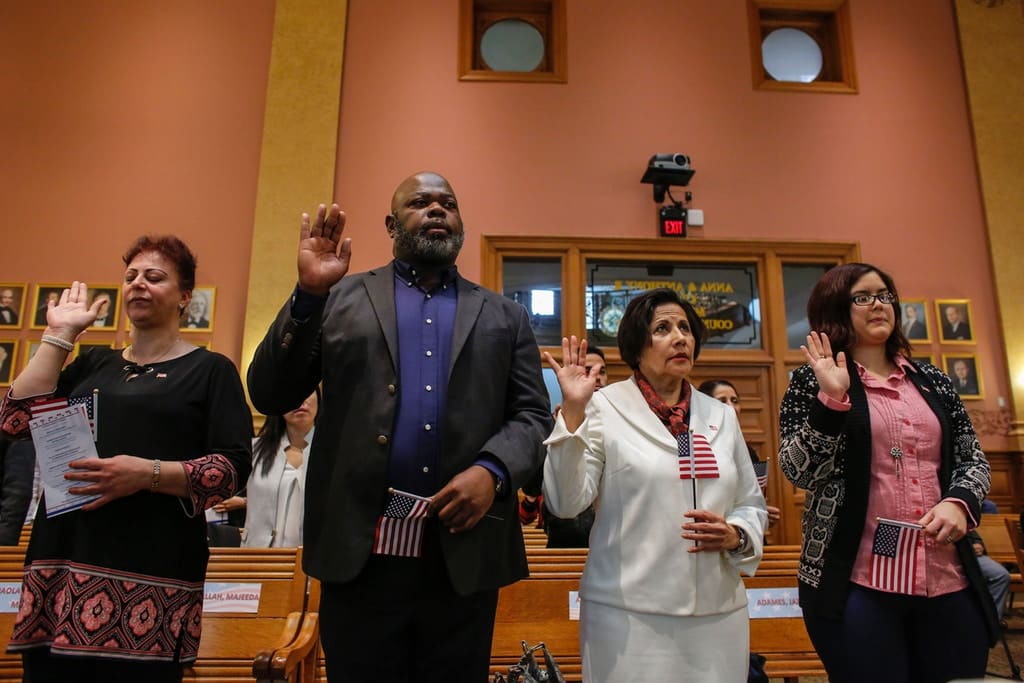February 18th 2018
For your Bits this weekend we get started taking a look at the history of poverty management systems. Virginia Eubanks traces the history of these systems from the “poorhouses” of the early 1800s through the increasingly digital welfare apparatus that exists today in the United States. Since their inception, poverty management systems have divided those who need help into the “impotent” (i.e. deserving) and “able” (i.e. undeserving). The system has served as a “moral thermometer [rather] than a floor that was under everybody protecting their basic human rights.” This means that the digitization of these systems has allowed for a more efficient way of policing the divide between those who “deserve” help and those who do not. This system must then deal with troublesome moral calculations that divide up limited resources between people in need while treating their privacy and civil rights with a different standard than other Americans.
The Rise of ‘Digital Poorhouses’

~ 19 Minute Read
“[CityLab:] You explore three specific case studies. The first is in Indiana, where lawmakers pushed to automate and privatize the welfare eligibility system—including cash assistance, food stamps, and Medicaid. What was the effect of that?
[Virginia Eubanks:] So in 2006, Indiana signed this really large contract—at the time, it was $1.16 billion—with a coalition of high-tech companies, including IBM and [Affiliated Computer Services (ACS)]. It replaced most local caseworkers with online forums and regional call centers that were staffed mostly by private employees.The result of this was 1 million benefit denials in the first three years of the project, which was a 54 percent increase from three years prior to automation. Mostly, folks were denied for a catch-all reason—“failure to cooperate in establishing eligibility”—which basically meant a mistake was made somewhere on the application.
[CityLab:] So, a technical issue with filling out a form. [Virginia Eubanks:] Yes, the rules became really brittle. And because people no longer had a personal relationship with their case workers, it then became very difficult for them to respond in way that meant they could retain their benefits. They were kind of on their own. [CityLab:] Explain the human cost of that. [Virginia Eubanks:] These applications can be anywhere from 20 to 120 pages long. So it’s very very tricky to go back and figure out where you may have made a mistake, or where the state had made a mistake, or where the document processing center had made a mistake. All mistakes ended up being the fault of the applicant. That really resulted in some some huge, life-shattering tragedies.One of the stories I tell in the book is about Omega Young, who was a 50-year-old African-American mom from Evansville, Indiana. She missed a phone appointment to re-certify for Medicaid because she was in the hospital suffering from terminal ovarian cancer. She did call the office ahead of time, to tell them she could make the time of the telephone appointment. But she was cut off anyway for “failure to cooperate in establishing eligibility.” She was unable to afford the medications, she had trouble paying rent, she lost access to free transportation to medical appointments. And though her family wouldn’t hold the state responsible for her death, she did succumb to cancer on March 1, 2009. The next day, on March 2, she won an appeal for wrongful termination of benefits and all of her benefits were restored.
So certainly, this process made her last days much more full of stress and suffering than they should have been.”
Click To Read The Full Article At CityLab.com
Sign Up To Receive Weekend Bits In Your Inbox Every Sunday
Our next article takes a look at how Facebook was caught off guard and allowed its product to be manipulated by malicious actors to sow social discord. Facebook began to take over the news in 2012 as a response to the rise of rival social network, Twitter, and ended up becoming the predominant channel for news publishers to reach their readers; however, in order to avoid regulation and liability for what is posted on its platform, Facebook has worked to avoid creating or editing content. This led to a platform that provided agnosticism when it came to deciding which content was truthful or valuable and thus became ripe for manipulation. By the 2016 U.S. election season malicious actors had realized that any content with strong engagement on Facebook could be quickly and broadly shared with little-to-no ad revenue. In fact, just six Facebook Groups controlled by a Kremlin-affiliated Russian troll farm were able to generate over 340 million shares with just 3,000 posts. The troll farm became adept at using Facebook to create discord by sharing false information that fed into existing American tribalism and even went so far as to organize events to both protest and support the same causes. Facebook’s self-deluding commitment to “agnosticism” allowed them to overlook the manipulation of their platform and, as a consequence, they have accelerated the dissemination of false information by enabling bad actors around the world.
Inside The Two Years That Shook Facebook-And The World

~ 55 Minute Read
“In fact, it was in besting just such a rival that Facebook came to dominate how we discover and consume news. Back in 2012, the most exciting social network for distributing news online wasn’t Facebook, it was Twitter. The latter’s 140-character posts accelerated the speed at which news could spread, allowing its influence in the news industry to grow much faster than Facebook’s. “Twitter was this massive, massive threat,” says a former Facebook executive heavily involved in the decisionmaking at the time.
So Zuckerberg pursued a strategy he has often deployed against competitors he cannot buy: He copied, then crushed. He adjusted Facebook’s News Feed to fully incorporate news (despite its name, the feed was originally tilted toward personal news) and adjusted the product so that it showed author bylines and headlines. Then Facebook’s emissaries fanned out to talk with journalists and explain how to best reach readers through the platform. By the end of 2013, Facebook had doubled its share of traffic to news sites and had started to push Twitter into a decline. By the middle of 2015, it had surpassed Google as the leader in referring readers to publisher sites and was now referring 13 times as many readers to news publishers as Twitter. That year, Facebook launched Instant Articles, offering publishers the chance to publish directly on the platform. Posts would load faster and look sharper if they agreed, but the publishers would give up an element of control over the content. The publishing industry, which had been reeling for years, largely assented. Facebook now effectively owned the news. “If you could reproduce Twitter inside of Facebook, why would you go to Twitter?” says the former executive. “What they are doing to Snapchat now, they did to Twitter back then.”
It appears that Facebook did not, however, carefully think through the implications of becoming the dominant force in the news industry. Everyone in management cared about quality and accuracy, and they had set up rules, for example, to eliminate pornography and protect copyright. But Facebook hired few journalists and spent little time discussing the big questions that bedevil the media industry. What is fair? What is a fact? How do you signal the difference between news, analysis, satire, and opinion? Facebook has long seemed to think it has immunity from those debates because it is just a technology company—one that has built a “platform for all ideas.”
This notion that Facebook is an open, neutral platform is almost like a religious tenet inside the company. When new recruits come in, they are treated to an orientation lecture by Chris Cox, the company’s chief product officer, who tells them Facebook is an entirely new communications platform for the 21st century, as the telephone was for the 20th. But if anyone inside Facebook is unconvinced by religion, there is also Section 230 of the 1996 Communications Decency Act to recommend the idea. This is the section of US law that shelters internet intermediaries from liability for the content their users post. If Facebook were to start creating or editing content on its platform, it would risk losing that immunity—and it’s hard to imagine how Facebook could exist if it were liable for the many billion pieces of content a day that users post on its site.
And so, because of the company’s self-image, as well as its fear of regulation, Facebook tried never to favor one kind of news content over another. But neutrality is a choice in itself. For instance, Facebook decided to present every piece of content that appeared on News Feed—whether it was your dog pictures or a news story—in roughly the same way. This meant that all news stories looked roughly the same as each other, too, whether they were investigations in The Washington Post, gossip in the New York Post, or flat-out lies in the Denver Guardian, an entirely bogus newspaper. Facebook argued that this democratized information. You saw what your friends wanted you to see, not what some editor in a Times Square tower chose. But it’s hard to argue that this wasn’t an editorial decision. It may be one of the biggest ever made.”
Click To Read The Full Article At Wired
Sign Up To Receive Weekend Bits In Your Inbox Every Sunday
Your last Bit of the weekend takes a look at how U.S. Immigrations and Customs Enforcement (ICE) uses the legal nuances around stripping citizenship from naturalized citizens to support its law enforcement objectives. The people who run the U.S. Justice system operate on the principle that they should be winning cases as prosecutors rather than trying to work towards a just and fair system. As a consequence they use any potential legal leverage to “inflict the most pain as possible, as efficiently as possible.” When it comes to ICE, this allows for politically motivated denaturalization cases where immigration officials will co-opt the responsibilities of U.S. attorneys to bring charges against naturalized citizens for errors in their naturalization paperwork. The maximum pain infliction comes when they choose to bring civil charges, which have a lower standard of proof and don’t require that defendants be provided with legal counsel, to force rulings that revoke the defendants U.S. citizenship allowing ICE to find other charges that can be used to initiate deportation proceedings. ICE’s mission creep has created an unjust power imbalance between the U.S. government and its citizens that results in Americans losing their rights.
How ICE Works To Strip Citizenship From Naturalized Americans

~ 12 Minute Read
“Immigration attorney Lance Curtright, who practices in San Antonio, Texas, told The Intercept that denaturalization can take two forms: civil and criminal. Criminal denaturalization is usually reserved for those who committed fraud to obtain citizenship for criminal activity — crimes involving terror, drugs, and the like — and carry jail terms of up to 25 years. Civil denaturalization is based on a lower standard of proof and doesn’t result in incarceration. “They’re different methods,” said Curtright, who added that he had noticed that the government pursuing more civil cases in recent months.
The handbook runs through the duties of each agent and the different types of infractions that can result in denaturalization proceedings. And it’s nowhere clearer than in the section of the manual that deals with “Case Strategy.” In this section, ICE instructs its investigative officers to push for charges that will lead to automatic denaturalization, rather than those charges which would require a separate process.
“Case agents,” the manual reads, “should encourage the U.S. Attorney’s Office prosecuting a case involving naturalization fraud or illegality to include a charge of ‘Procurement of Citizenship or Naturalization Unlawfully’ under 18 U.S.C. § 1425 because, upon conviction, the court is required to revoke the defendant’s citizenship.”
“On the other hand,” the manual goes on, “a conviction for ‘False Statements’ under 18 U.S.C. § 1001 does not require the automatic revocation of a defendant’s citizenship and will result in the U.S. Government having to engage in a separate denaturalization prosecution.”
This centralization of the denaturalization process puts the onus for instituting proceedings on HSI agents. That’s indicative of a push to take away the authority provided for under the law to U.S. attorneys working in those jurisdictions, said Smith. He said that the way things are now, cases are put together by special agents in the HSI and then given to U.S. attorneys. “We don’t think it is in keeping with the statute,” said Smith.
The strategy section continues, warning agents that settling for civil infractions carries the risk that the targets of investigations may be able to retain citizenship. If the U.S. Attorney’s Office can’t be convinced to prosecute under criminal infractions, the handbook says, a settlement should be reached, if possible, with the defendant, including civil denaturalization — though that’s not ideal: “Civil denaturalization under 8 U.S.C. § 1451(a) may not result in a deportable charge against the defendant.”
Stock explained that by combining charges, the government was setting the case up to take care of everything all at once with the end goal of deportation. It’s brutal efficiency, she told The Intercept: “They want to go for the jugular.””
Click To Read The Full Article At The Intercept
Thanks for checking out the Weekend Bits! If you enjoyed these Bits, why don’t you share it with a friend? We appreciate your support and as always, Contact Us online or send us an email at [email protected].
Have a great rest of your week!